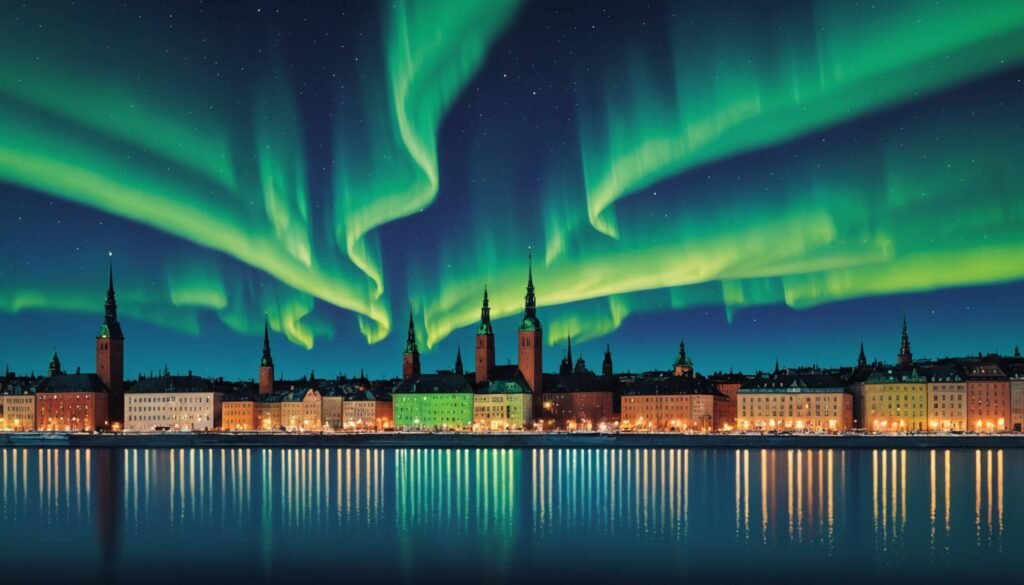Northern Lights in Stockholm: 5 Spots for Aurora Hunting
The enchanting dance of the Northern Lights, or Aurora Borealis, is a spectacle that captivates the hearts of many. While Stockholm, the capital of Sweden, may not be the first place that comes to mind for aurora hunting, it’s possible to witness this magical phenomenon near the city under the right conditions. Let’s explore five incredible spots where you might catch a glimpse of the Northern Lights in Stockholm, and delve into the best practices for aurora hunting in Sweden’s vibrant capital.
Understanding the Northern Lights
Before we embark on our aurora adventure, it’s crucial to understand what causes this celestial display. The Northern Lights are the result of solar particles colliding with the Earth’s atmosphere, creating a mesmerising light show in the sky. While Sweden’s northern regions offer prime viewing spots for the aurora, Stockholm’s southern location doesn’t rule out the possibility entirely.
Best Time to See Northern Lights in Stockholm
The prime season for spotting the Northern Lights in Stockholm typically runs from late September to early April. During these months, the nights are longer, providing more opportunities for aurora sightings. However, clear skies and strong solar activity are essential for visibility. Keep an eye on aurora forecasts and plan your outings accordingly.
5 Spots for Aurora Hunting near Stockholm
1. Tyresta National Park
Located just 20 kilometres southeast of Stockholm, Tyresta National Park offers a perfect escape from the city lights. Its vast, open spaces and minimal light pollution create ideal conditions for stargazing and potentially spotting the Northern Lights. The park’s ancient forest adds a mystical backdrop to your aurora hunting experience.
2. Järvafältet Nature Reserve
Situated north of Stockholm, Järvafältet Nature Reserve provides a convenient location for city dwellers to escape the urban glow. Its open fields and lakes offer unobstructed views of the night sky, increasing your chances of witnessing the aurora. The reserve is easily accessible by public transport, making it a popular choice for locals and tourists alike.
3. Hellasgården
Just a short drive from central Stockholm, Hellasgården is a recreational area that offers a blend of nature and amenities. Its location by Lake Källtorpssjön provides a stunning reflection of the sky, potentially doubling your aurora viewing pleasure. The area also offers warm indoor spaces, perfect for warming up between aurora-watching sessions.
4. Sandhamn
For those willing to venture a bit further, the island of Sandhamn in the Stockholm archipelago presents a unique aurora hunting opportunity. The island’s remote location and minimal light pollution create excellent conditions for spotting the Northern Lights. The journey to Sandhamn itself is an adventure, offering a glimpse into the archipelago’s beauty.
5. Fjärdlång
Another gem in the Stockholm archipelago, Fjärdlång island boasts pristine nature and dark skies. Its elevated viewpoints provide panoramic vistas of the surrounding sea and sky, perfect for aurora watching. The island’s tranquil atmosphere allows for a peaceful and immersive Northern Lights experience.
Tips for Aurora Hunting in Stockholm
To maximise your chances of seeing the Northern Lights near Stockholm, consider these essential tips:
- Check aurora forecasts regularly
- Choose clear, cold nights for the best visibility
- Avoid full moon nights as they can interfere with aurora visibility
- Bring warm clothing, as temperatures can drop significantly at night
- Pack hot beverages and snacks for comfort during long waits
- Use a camera with manual settings to capture the aurora
Embracing the Winter Magic
While waiting for the elusive Northern Lights, embrace the winter magic that Stockholm has to offer. Swedish Christmas traditions and winter activities can enhance your aurora hunting experience, making every moment memorable regardless of whether you catch a glimpse of the lights.
The Cultural Significance of Northern Lights
The Northern Lights hold a special place in Swedish folklore and culture. Ancient Norse beliefs attributed the lights to the reflections from the shields of the Valkyries, while Sami traditions saw them as a celestial fire. Today, they continue to inspire awe and wonder, drawing people from around the world to witness their beauty.
Beyond Aurora Hunting: Exploring Stockholm
While aurora hunting is an exciting prospect, Stockholm offers a wealth of experiences beyond the Northern Lights. From its rich history and stunning architecture to its vibrant food scene and cultural attractions, the city is a destination in its own right. Exploring Sweden’s must-visit places, including Stockholm’s attractions, can make your trip unforgettable, even if the aurora remains elusive.
Conclusion
While Stockholm may not be the most renowned destination for Northern Lights viewing, the possibility of witnessing this natural wonder adds an element of excitement to any visit. By venturing to these five spots near the city and following our tips, you increase your chances of experiencing the magic of the aurora. Remember, the journey of aurora hunting is as rewarding as the destination, offering unique experiences and memories that last a lifetime.
FAQ
What are the chances of seeing Northern Lights in Stockholm?
The chances of seeing Northern Lights in Stockholm are lower compared to northern Sweden, but it’s still possible. Clear skies, strong solar activity, and minimal light pollution increase your odds. While not guaranteed, patience and proper planning can lead to successful sightings.
Can I see Northern Lights from Stockholm city centre?
It’s extremely rare to see Northern Lights from Stockholm’s city centre due to light pollution. Your best bet is to venture to darker areas on the outskirts of the city or in nearby nature reserves for a better chance of spotting the aurora.
What should I wear when aurora hunting near Stockholm?
Dress in warm, insulated layers when aurora hunting near Stockholm. Thermal underwear, a warm coat, hat, gloves, and insulated boots are essential. Remember, you’ll be standing still for long periods in cold temperatures, so prioritise warmth and comfort.

